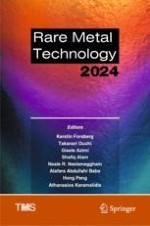This collection presents papers from a symposium on extraction of rare metals from primary and secondary materials and residues as well as rare extraction processing techniques used in metal production. The collection covers the extraction of less common or minor metals including elements such as antimony, bismuth, barium, beryllium, boron, calcium, chromium, gallium, germanium, hafnium, indium, manganese, molybdenum, platinum group metals, rare earth metals, rhenium, scandium, selenium, sodium, strontium, tantalum, tellurium, and tungsten. It also includes rare metals of low-tonnage sales compared to high-tonnage metals (iron, copper, nickel, lead, tin, zinc, or light metals such as aluminum, magnesium, or titanium and electronic metalloid silicon). Rare metal processing covers bio-metallurgy, hydro-metallurgy, and electro-metallurgy while novel high-temperature processes such as microwave heating, solar-thermal reaction synthesis, and cold crucible synthesis of rare metals are also addressed. Also included in this collection is the design of extraction equipment used in these processes from suppliers as well as laboratory and pilot plant studies.
